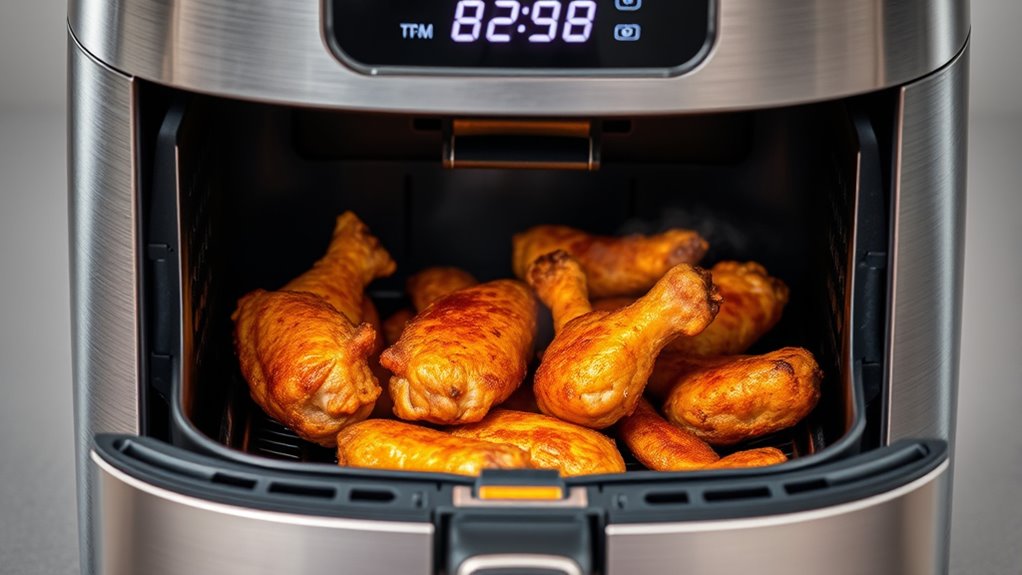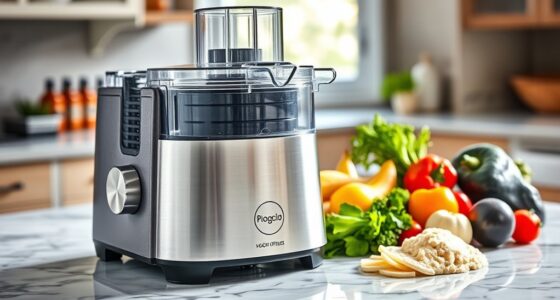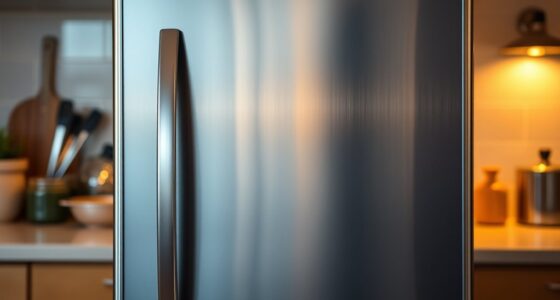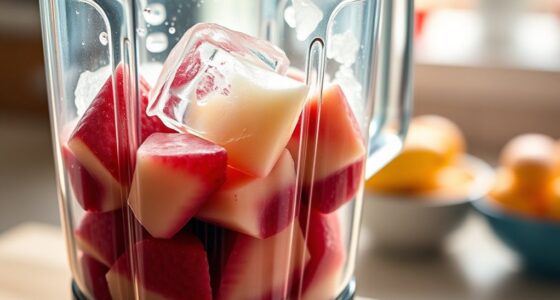To achieve restaurant-quality crispy frozen food in your air fryer, set it between 375°F and 400°F, preheat for 3-5 minutes, and avoid overcrowding. Shake or flip the food midway to guarantee even browning and use light coatings or sprays of oil to boost crispiness. Incorporating accessories like parchment liners or wire racks helps with heat circulation. For all tips and techniques to perfect your crispy results, explore further details below.
Key Takeaways
- Preheat the air fryer at 400°F for 3-5 minutes to ensure even heat distribution and optimal crispiness.
- Use a cooking temperature between 375°F and 400°F, adjusting based on food thickness and desired crunch.
- Arrange food in a single layer, shake or flip halfway, to promote uniform browning and restaurant-quality texture.
- Apply a light, even coating of oil or batter to enhance crispiness without sogginess.
- Incorporate accessories like parchment liners or wire racks to improve heat circulation and achieve consistent results.
Understanding the Perfect Temperature for Crispy Results
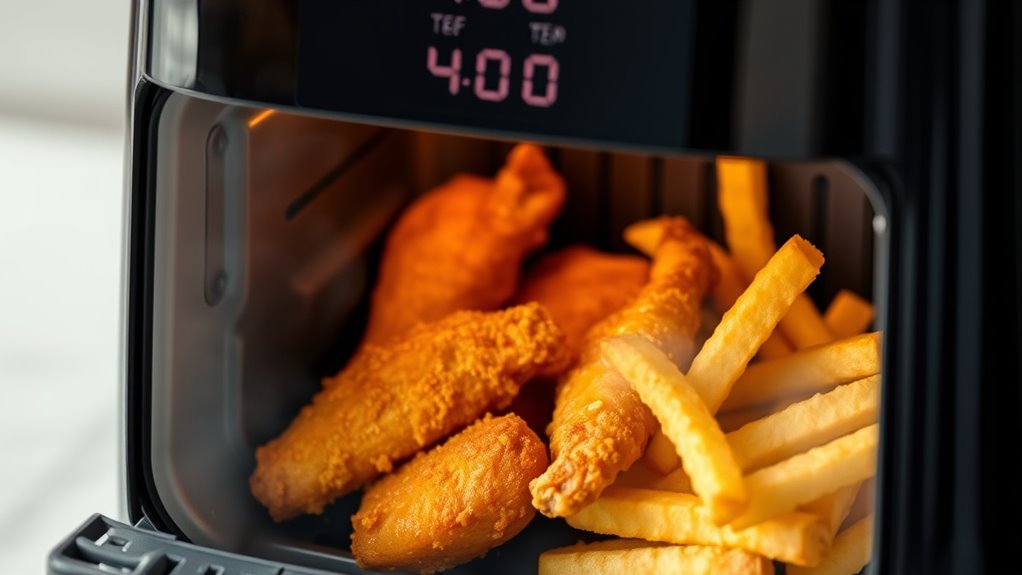
Getting crispy, golden-brown results from frozen food in your air fryer depends largely on setting the right temperature. If you don’t, you risk uneven cooking or soggy textures. Generally, a temperature range of 375°F to 400°F works best for most frozen items. Higher temperatures help achieve that perfect crunch while keeping interior moisture intact. Start with 400°F for crispy snacks like fries or chicken wings, but adjust if needed based on the food’s thickness and type. Keep in mind that going too high can burn the exterior before the inside cooks properly. Conversely, too low might lead to sogginess. Finding the right temperature is key to getting that restaurant-quality, crispy finish every time you air fry your frozen favorites. Proper heat refrigeration cycle management can also influence how evenly your food crisps up, especially since fluctuations in temperature can affect the cooking process. Additionally, preheating the air fryer can help maintain consistent cooking temperatures, ensuring better results.
Optimal Time Settings for Various Frozen Foods
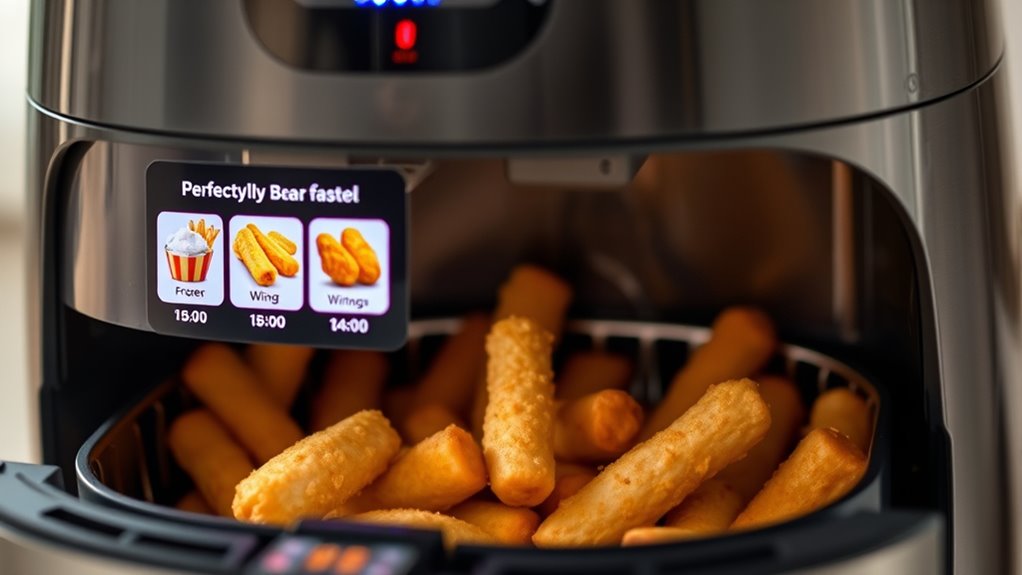
Choosing the right cooking time is just as important as setting the correct temperature when preparing frozen foods in your air fryer. For most frozen vegetables, 8-10 minutes at 400°F usually works well, giving you crispy edges without overcooking. Frozen chicken nuggets or strips typically need 10-12 minutes at 400°F for a golden, crispy exterior. French fries often take 15-20 minutes at 400°F, depending on thickness. For frozen fish fillets, 8-10 minutes at 400°F delivers flaky, crispy results. Keep in mind that thicker or larger items may require additional time. Always check your food midway to prevent overcooking, and adjust timing based on your specific air fryer model and personal preferences. Proper timing ensures perfectly cooked frozen foods every time.
Preheating Your Air Fryer for Even Cooking
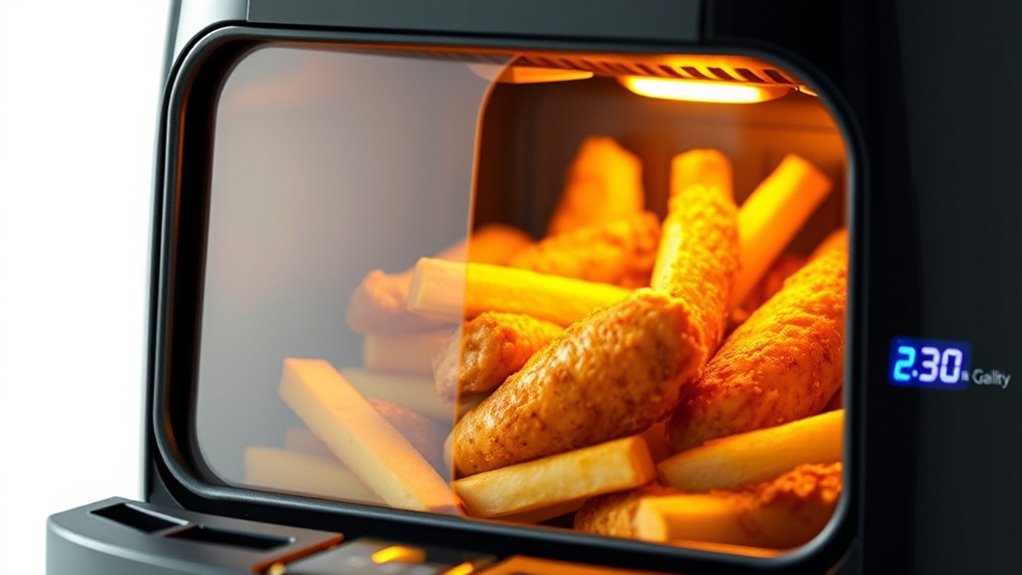
Preheating your air fryer before cooking guarantees even heat distribution and helps achieve crispier, more consistent results. It’s similar to preheating an oven; it guarantees the entire cooking chamber reaches the right temperature, reducing uneven cooking or cold spots. To preheat, set your air fryer to the desired temperature and let it run for 3-5 minutes before adding your frozen food. This quick step allows the internal components to stabilize, so your food cooks evenly from the start. Proper preheating is especially important for frozen items, which can take longer to cook thoroughly. By investing a few minutes in preheating, you’ll notice improved texture, better browning, and more predictable cooking times, giving your frozen foods that restaurant-quality finish. Proper filtration and pump protection can also ensure consistent operation, especially when using the air fryer frequently. Additionally, maintaining clean airflow within the appliance supports even heat distribution and efficient performance, leading to better cooking results. Regular maintenance can also prevent potential vulnerabilities in the appliance’s operation, ensuring safety and longevity.
The Importance of Shaking or Flipping During Cooking
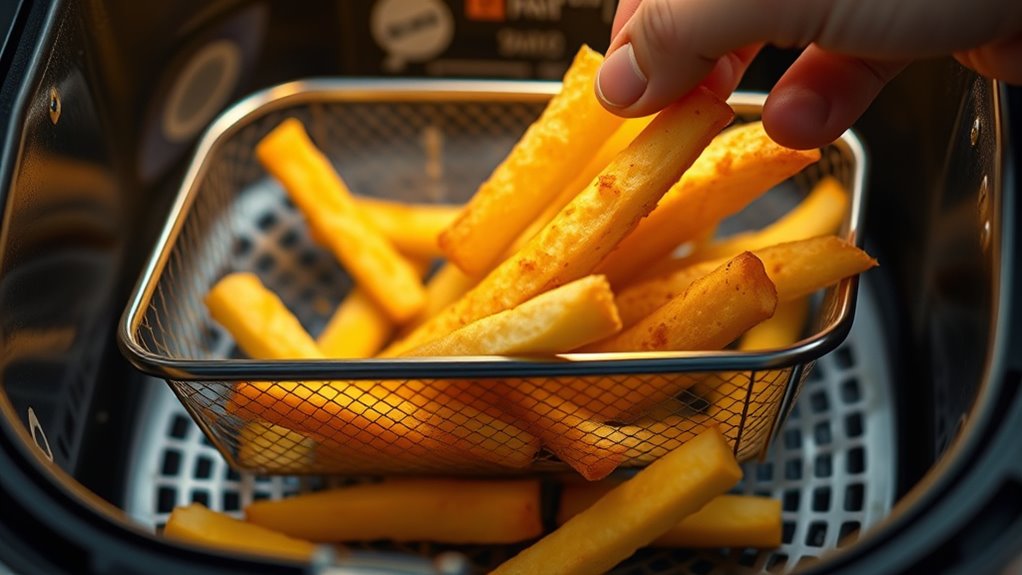
Shaking or flipping your food halfway through guarantees it cooks evenly and prevents hot spots. It also helps maintain that perfect crispy texture you’re after. Don’t forget to do it—your food will come out better every time. Additionally, proper exfoliation techniques can enhance the overall texture and appearance of your skin, similar to how flipping ensures even cooking. Regularly rotating food during cooking can further optimize results and avoid uneven browning. Using vintage cookware in a farmhouse-style kitchen can also contribute to consistent heat distribution and better cooking outcomes. Incorporating durable vacuum cleaners can help keep your kitchen free of crumbs and debris, ensuring a cleaner environment for your cooking adventures. Moreover, utilizing wall organization systems can keep your kitchen tools and accessories within easy reach, streamlining the cooking process.
Uneven Cooking Prevention
To prevent uneven cooking in your air fryer, it’s important to shake or flip the food halfway through the process. This simple step ensures each piece gets equal heat, preventing cold spots or overcooked edges. Regularly flipping or shaking keeps the food moving, promoting uniform crispiness and doneness. Imagine biting into perfectly cooked, evenly golden fries or crispy chicken—without the frustration of uneven textures. Incorporating these techniques can help you maximize your results and achieve restaurant-quality dishes at home. Using French press operation to prepare coffee can also inspire your cooking techniques, encouraging attention to detail and consistency. Additionally, using crochet tools to create a variety of protective styles can also make meal prep more enjoyable by keeping your hair neat and out of the way during cooking. Being mindful of angel number symbolism can also inspire patience and trust in the cooking process, leading to better results.
Crispy Texture Enhancement
Maintaining a crispy texture in your frozen food relies heavily on flipping or shaking it during cooking. This simple step ensures heat is evenly distributed, preventing soggy spots and promoting uniform crispiness. When you shake or flip, you expose all sides to the hot air, helping the outer layer stay crunchy. It also stops food from sticking together or settling unevenly, which can cause uneven browning. For best results, pause the air fryer halfway through cooking to shake the basket or flip larger pieces manually. Doing this regularly keeps the texture consistent, making your food resemble restaurant-quality dishes. Additionally, proper airflow plays a crucial role in achieving that perfect crisp. Proper air circulation ensures consistent heat distribution and prevents the formation of moisture that can cause sogginess. To maximize crispiness, consider temperature control techniques that optimize heat levels throughout the cooking process. Remember, patience and attention during the process make all the difference in achieving that perfect crispy exterior. A well-maintained air fryer environment also contributes to better results by promoting even cooking and crispiness. Regularly cleaning the air fryer basket helps maintain optimal airflow and prevents residue buildup that can impede crisping.
Using Light Coatings to Enhance Crispiness
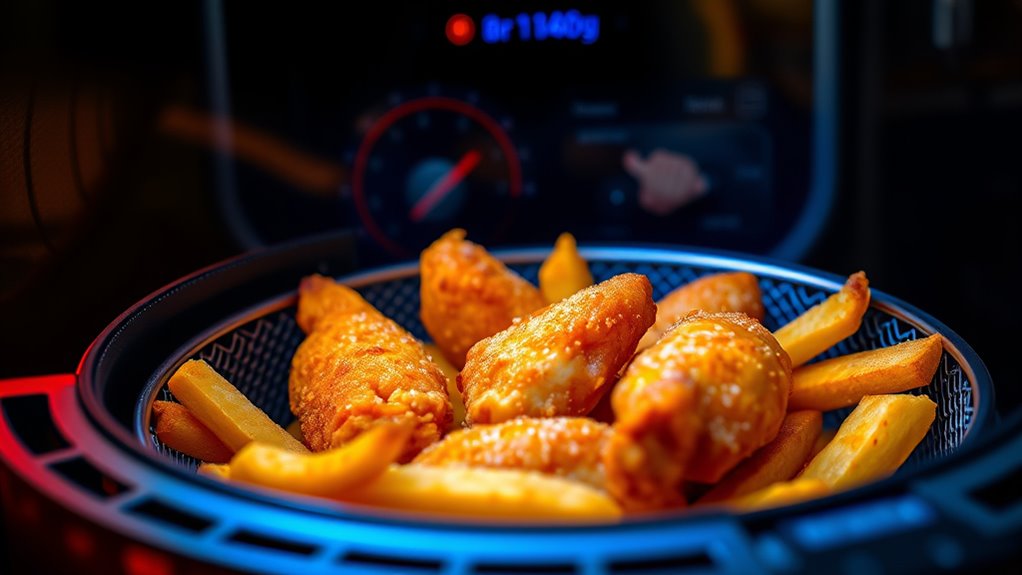
Applying a light coating can make your frozen food crispier in the air fryer. The key is to guarantee the coating is even and not too thick, so it browns properly. When done right, it enhances texture without adding unnecessary calories. Proper tuning techniques can also optimize cooking results and improve the overall crispiness of your food. For best results, experimenting with different dehydration levels can help achieve the ideal texture and flavor. Additionally, selecting the right coating ingredients can significantly impact crispiness and flavor development. Understanding relationship dynamics and communication can also create a more enjoyable cooking experience, especially when trying new techniques. Moreover, using appropriate tools like a spray bottle or silicone brush can help distribute coatings evenly for superior crispiness.
Light Coatings Boost Crispiness
Using a light coating of oil or batter can substantially boost the crispiness of frozen foods in your air fryer. This thin layer promotes even browning and creates a satisfying crunch without excess grease. Experimenting with different coatings enhances texture and flavor—think egg wash, cornstarch, or breadcrumbs. The key is to keep the coating light to avoid sogginess and ensure proper airflow.
| Coating Type | Best For |
|---|---|
| Oil Spray | General crispiness and sheen |
| Egg Wash | Breading adhesion and crunch |
| Cornstarch | Extra crispiness for wings |
Proper Application Matters
To maximize the benefits of light coatings, proper application techniques are key. You want just enough to create a crisp exterior without adding excess weight or moisture. Before air frying, lightly brush or spray your food with oil, then apply a thin layer of your chosen coating—such as cornstarch, breadcrumbs, or seasoned flour. Shake off any excess to prevent clumping and uneven browning. Be careful not to over-coat, as thick layers can hinder crispiness and increase cooking time. Consistent, even coverage ensures a uniform crunch and enhances flavor. Remember, the goal is a delicate, crispy exterior that complements the tender interior. Proper application not only improves texture but also helps your food cook more evenly, elevating your frozen dishes to restaurant quality.
Adjusting Time and Temperature for Different Thicknesses
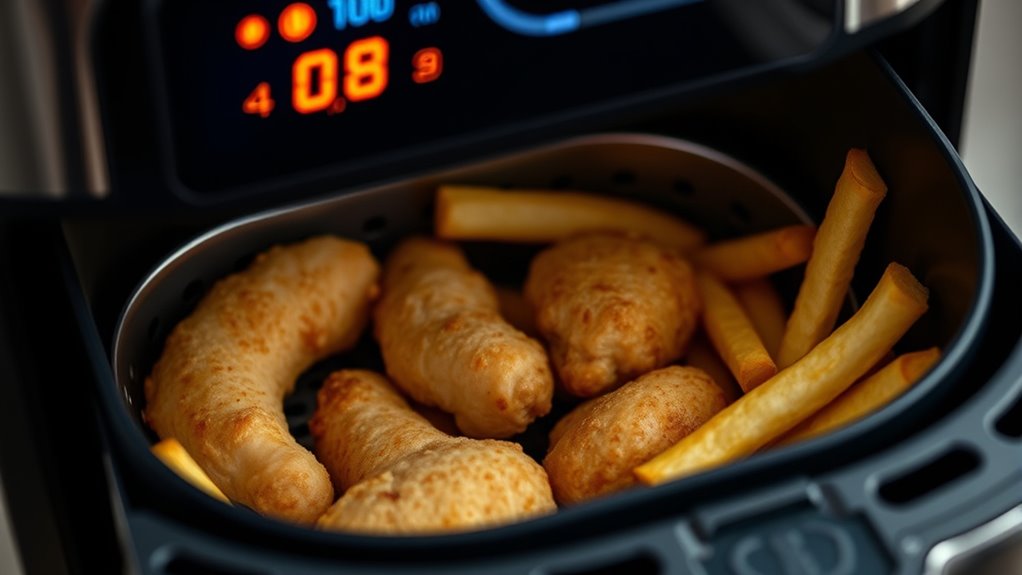
Since thicker frozen foods take longer to cook through, you’ll need to modify your air fryer’s time and temperature settings accordingly. For thicker cuts like drumsticks or large fish fillets, increase the cooking time by about 20-30%, and consider raising the temperature slightly to ensure even cooking. Conversely, thinner items like frozen fries or small chicken strips require less time; reduce the cooking duration to prevent overcooking. Keep in mind that larger or denser foods may need a few extra minutes at a higher temperature, but avoid overdoing it to prevent burning. Always check for doneness before removing your food, and adjust your settings based on the specific thickness to achieve crispy, evenly cooked results.
Incorporating Air Fryer Accessories for Better Results
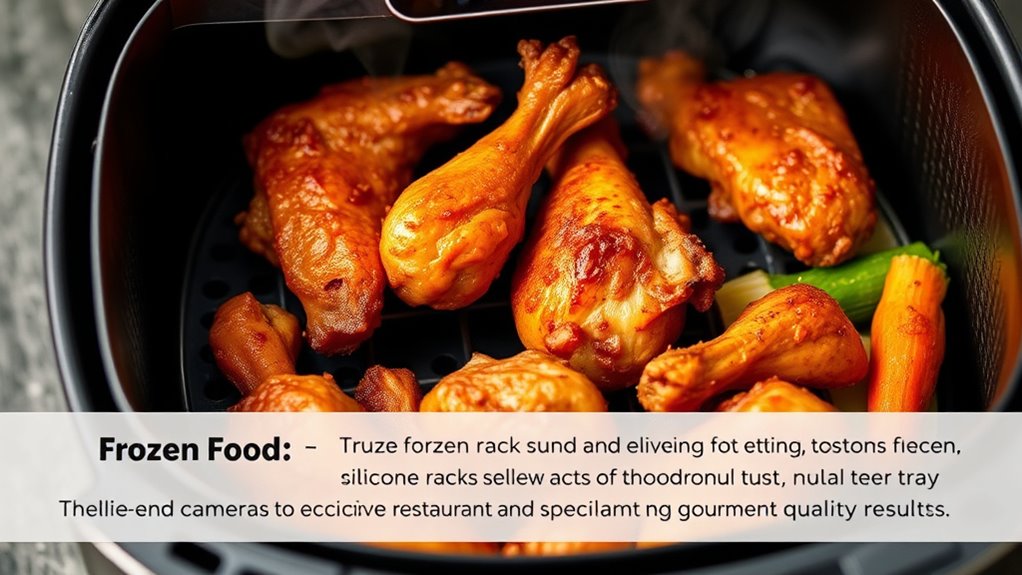
Incorporating the right accessories can considerably improve your air fryer results by promoting even cooking and easier cleanup. Using tools like parchment liners, silicone mats, or wire racks helps distribute heat uniformly and prevents sticking. These accessories also make cleaning simpler, saving you time and effort. Consider the following options:
| Accessory | Purpose | Benefit |
|---|---|---|
| Parchment Liners | Catch drips and crumbs | Keeps basket clean |
| Silicone Mats | Provide non-stick surface | Prevents food from sticking |
| Wire Racks | Elevate food for airflow | Ensures even crispiness |
Choosing the right accessories tailors your air frying experience, delivering tastier, more consistent results.
Avoiding Common Mistakes That Soothe the Crispy Texture
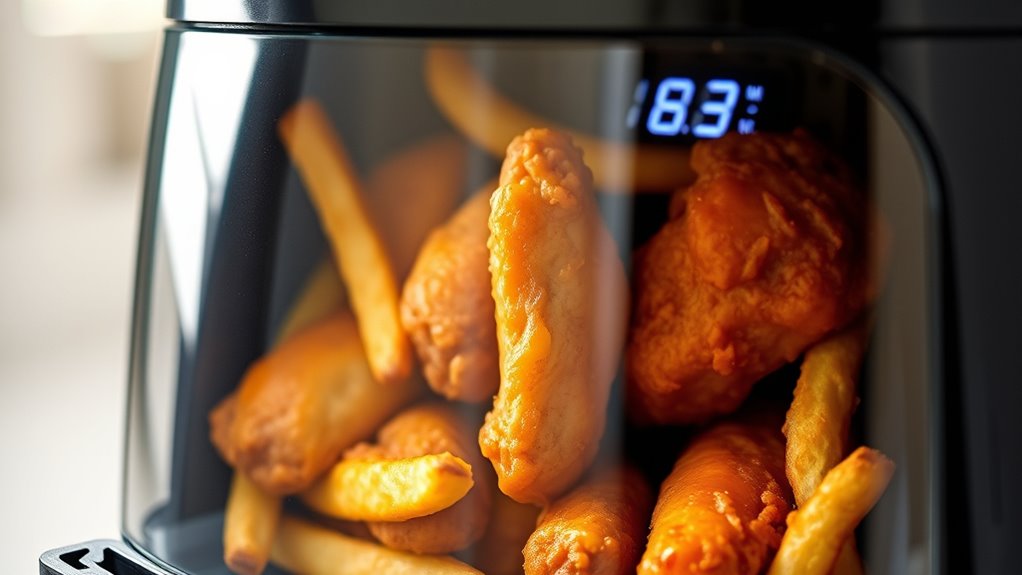
Avoiding common mistakes is key to maintaining that perfect crispy texture when using your air fryer. One mistake to watch out for is overcrowding the basket, which traps steam and prevents even crisping. Always leave space between items to allow air to circulate freely. Using too much oil can also soften the exterior, so apply just a light coating if needed. Another error is setting the temperature too high, which can burn the outside while leaving the inside undercooked. Instead, stick to recommended temperatures and check food periodically. Finally, avoid rushing the process by opening the basket too often; this releases heat and prolongs cooking. Staying mindful of these pitfalls helps ensure your food stays crispy and delicious.
Tips for Achieving Uniform Browning Every Time
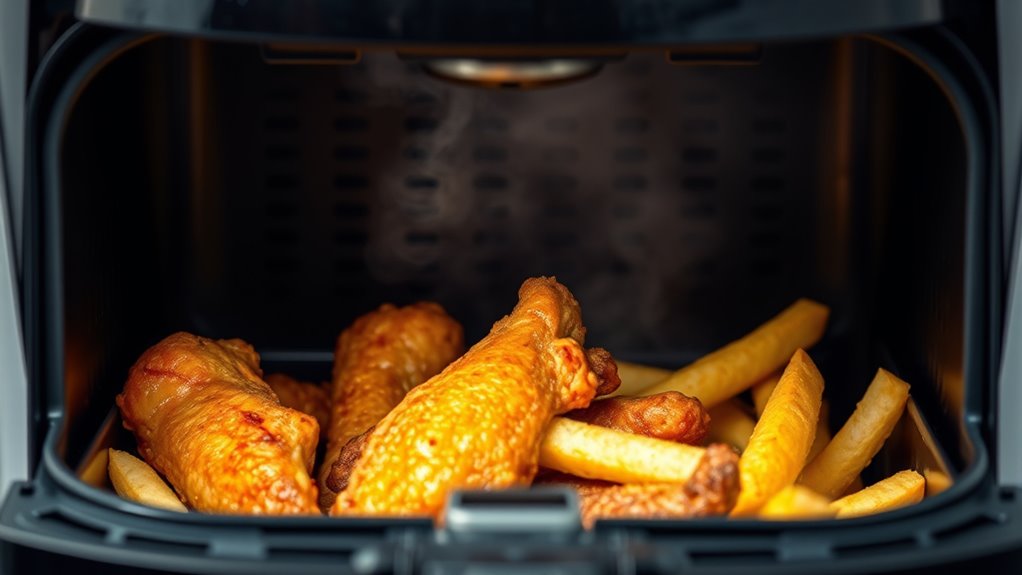
Achieving uniform browning with your air fryer requires paying close attention to how you arrange and prepare your food. Spread pieces in a single layer, avoiding overcrowding, so hot air circulates evenly. Shake or flip your items halfway through cooking to promote consistent color and crispiness. Thin or delicate foods may brown faster; adjust the time or temperature accordingly. For larger or thicker pieces, consider pre-treating with a light spray of oil to enhance browning without making them greasy. Use a parchment liner or a perforated basket to improve airflow around your food. Ultimately, monitor your cooking process closely—every model varies—so you can make small adjustments for perfectly browned results every time.
Cleaning and Maintenance for Consistent Performance
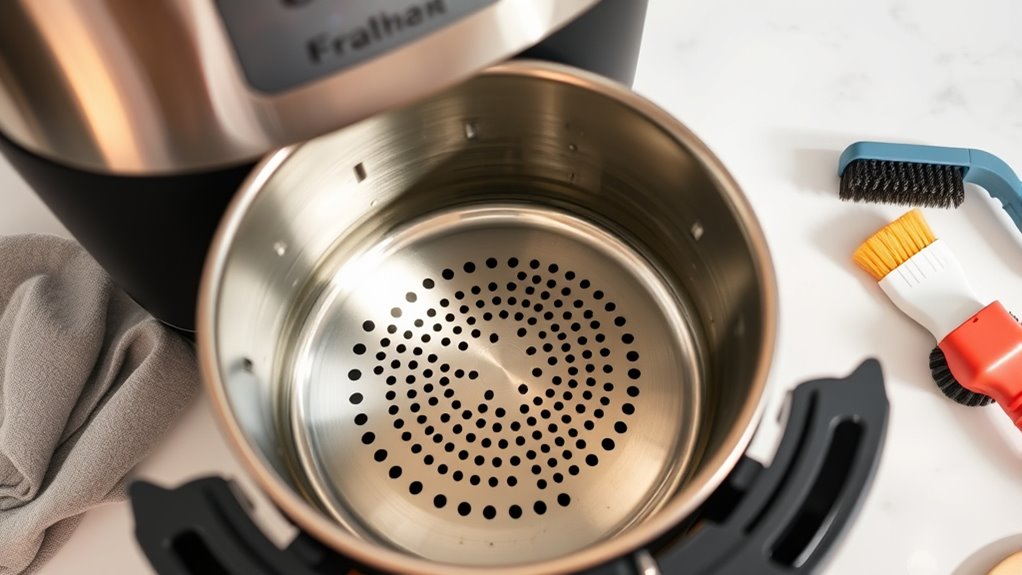
Regular cleaning and maintenance are essential to guarantee your air fryer performs consistently and produces the best results. A clean fryer heats evenly and prevents unwanted flavors or smoke. To keep it in top shape, regularly wipe down the interior with a damp cloth and remove any food debris. Check and clean the heating element and fan to avoid buildup that can hinder performance. Also, don’t forget to clean the basket and tray thoroughly after each use to prevent residue buildup.
- Remove and wash the basket and tray with warm, soapy water
- Wipe down the interior and exterior with a damp cloth
- Inspect and clean the heating element and fan regularly
Frequently Asked Questions
Can I Cook Multiple Frozen Items Simultaneously Without Affecting Quality?
Sure, you can toss multiple frozen items into your air fryer—just like a chaotic chef in a sitcom. But don’t expect perfect results. Overcrowding traps steam, making food soggy, and extending cooking times. For best results, give each item space to breathe and cook evenly. Remember, quality over quantity wins the day, so don’t cram that basket too full unless you’re aiming for a soggy, underdone mess.
How Do Different Brands of Frozen Foods Impact Cooking Times?
Different brands of frozen foods can impact your cooking times because of variations in thickness, coating, and moisture content. You might find that some brands require slightly longer or shorter cook times to reach crispy, evenly cooked results. To get the best outcome, always check the package instructions first, but be prepared to adjust your air fryer settings based on your experience with each brand.
Is There a Specific Air Fryer Brand Better for Frozen Foods?
Did you know that 85% of users prefer air fryers with adjustable temperature controls? When choosing a brand, focus on those with precise settings and consistent performance, like Philips or Ninja. These brands often deliver better results for frozen foods, ensuring even cooking and crispiness. Ultimately, select an air fryer that fits your needs and offers reliable results, making frozen meals taste restaurant-quality every time.
How Do I Prevent Food From Sticking to the Air Fryer Basket?
To prevent food from sticking to your air fryer basket, start by lightly spraying it with non-stick spray or brushing it with oil. Make sure your food isn’t too wet or sticky before placing it in the basket. Shake or turn the food halfway through cooking to promote even crisping and prevent sticking. Using parchment paper liners designed for air fryers can also help keep your basket clean and food from sticking.
What Are the Best Ways to Reheat Cooked Frozen Foods in the Air Fryer?
When reheating cooked frozen foods in your air fryer, you want to make certain they stay crispy and don’t dry out. Preheat your air fryer to around 350°F. Place the food in a single layer, avoiding overcrowding. Reheat for 3-5 minutes, shaking or flipping halfway through. Check if it’s heated through, then serve. This method keeps your leftovers tasting fresh and delicious.
Conclusion
Think of your air fryer as a skilled artist’s brush, bringing your frozen favorites to life with perfect crispness. When you master the right settings, preheat, and care, you’re painting a masterpiece of flavor and texture every time. With a little practice, you’ll turn simple frozen foods into culinary canvas masterpieces—crispy, golden, and restaurant-quality. Embrace the process, and soon your air fryer will be your trusted brush for delicious creations.
